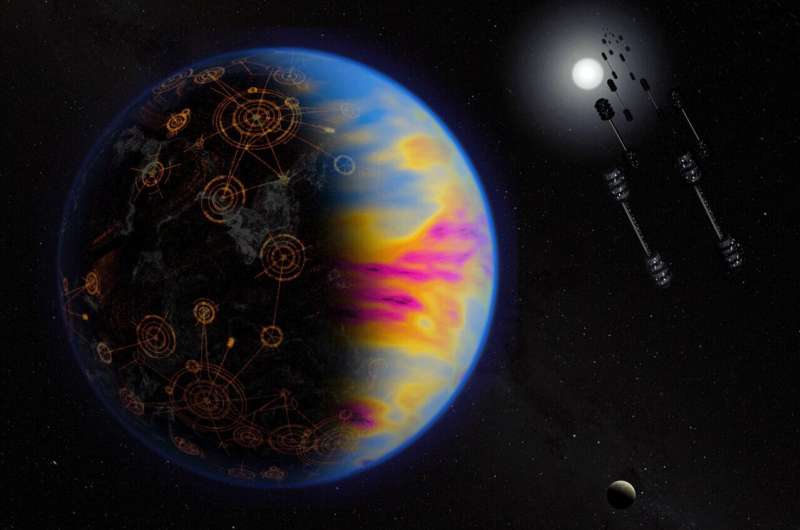This article has been reviewed according to Science X's editorial process and policies. Editors have highlighted the following attributes while ensuring the content's credibility:
fact-checked
peer-reviewed publication
trusted source
proofread
Scientists discuss why we might not spot solar panel technosignatures

One of NASA's key priorities is understanding the potential for life elsewhere in the universe. NASA has not found any credible evidence of extraterrestrial life—but NASA is exploring the solar system and beyond to help us answer fundamental questions, including whether we are alone in the universe.
For those who study the potential for life beyond Earth, one of the questions has long been trying to determine the likelihood of microbial life versus complex life versus a civilization so advanced that we can spot signs of it, called technosignatures, from here at home. Studying the answers to questions like that can help guide suggestions on new telescopes or missions to emphasize the most likely places and ways to look for life.
Now a recent paper published May 24 in the Astrophysical Journal postulates that if advanced extraterrestrial civilizations exist, one reason they might be hard to detect with telescopes from our vantage point is because their energy requirements may be relatively modest. If their culture, technology, and population size do not need vast amounts of power, they would not be required to build enormous stellar-energy harvesting structures that could be detected by current or proposed telescopes. Such structures, based on our own Earthly experience, might be solar panel arrays that cover a significant portion of their planet's surface or orbiting megastructures to harness most of their parent star's energy—both of which we might be able to spot from our own solar system.
"We found that even if our current population of about 8 billion stabilizes at 30 billion with a high standard of living, and we only use solar energy for power, we still use way less energy than that provided by all the sunlight illuminating our planet," said Ravi Kopparapu of NASA's Goddard Space Flight Center in Greenbelt, Maryland, lead author of the paper.
The study has implications for the Fermi paradox, postulated by physicist Enrico Fermi, which asks the question that since our galaxy is ancient and vast, and interstellar travel is difficult but possible, why hasn't an alien civilization spread across the galaxy by now?
"The implication is that civilizations may not feel compelled to expand all over the galaxy because they may achieve sustainable population and energy-usage levels even if they choose a very high standard of living," said Kopparapu. "They may expand within their own stellar system, or even within nearby star systems, but a galaxy-spanning civilizations may not exist."
Additionally, our own technological expertise may not yet be able to predict what more advanced civilizations could do.
"Large-scale stellar-energy harvesting structures may especially be obsolete when considering technological advances," adds Vincent Kofman, a co-author of the paper at NASA Goddard and American University, Washington, D.C. "Surely a society that can place enormous structures in space would be able to access nuclear fusion or other space-efficient methods of generating power."
The researchers used computer models and NASA satellite data to simulate an Earth-like planet with varying levels of silicon solar panel coverage. The team then modeled an advanced telescope like the proposed NASA Habitable Worlds Observatory to see if it could detect solar panels on the planet about 30 light-years away, which is relatively nearby in a galaxy that spans over 100,000 light-years. They found that it would require several hundreds of hours of observing time with that type of telescope to detect signatures from solar panels covering about 23% of the land area on an Earth-like exoplanet. However, the requirement for 30 billion humans at a high-living standard was only about 8.9% solar-panel coverage.
Extraterrestrial civilizations with advanced technology could be discovered by their technosignatures—observational manifestations of extraterrestrial technology that could be detected or inferred through astronomical searches. For decades, scientists have been using radio telescopes to look for potential extraterrestrial radio transmissions. More recently, astronomers have proposed using a telescope like the Habitable Worlds Observatory to look for other kinds of technosignatures, such as chemical "fingerprints" in exoplanet atmospheres or specific characteristics in the light reflected by an exoplanet that might announce the presence of vast silicon solar arrays.
The new study assumes that extraterrestrials would build solar panels out of silicon because it's relatively abundant compared to other elements used in solar power, such as germanium, gallium, or arsenic. Also, silicon is good at converting the light emitted by Sun-like stars into electricity and it's cost-effective to mine and manufacture into solar cells.
The researchers also assume that a hypothetical extraterrestrial civilization would rely exclusively on solar energy. However, if other sources of energy are used, such as nuclear fusion, it would reduce the silicon technosignature, making the civilization even harder to detect. The study further assumes that the civilization's population stabilizes at some point. If this doesn't happen for whatever reason, perhaps they will be driven to expand ever-father into deep space. Finally, it's impossible to know if an advanced civilization may be using something we haven't imagined yet that requires immense amounts of power.
More information: Ravi Kopparapu et al, Detectability of Solar Panels as a Technosignature, The Astrophysical Journal (2024). DOI: 10.3847/1538-4357/ad43d7
Journal information: Astrophysical Journal
Provided by NASA's Goddard Space Flight Center



















